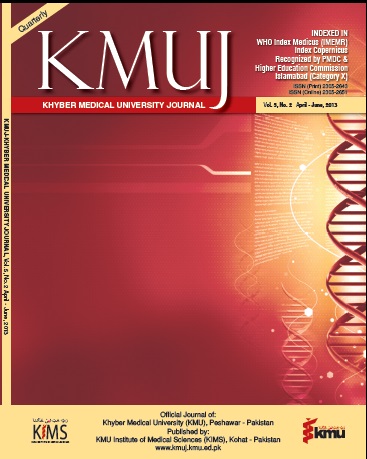COMPARISON OF MUTAGEL HFE AND POLYMERASE CHAIN REACTIONRESTRICTION FRAGMENT LENGTH POLYMORPHISM (PCR-RFLP) FOR THE INVESTIGATION OF C282Y AND H63D POINT MUTATION IN HFE GENE
Main Article Content
Abstract
OBJECTIVE: To compare MutaGel HFE (commercial kit based on ARMSPCR)with in-house designed polymerase chain reaction-restrictionfragment length polymorphism (PCR-RFLP) techniques for the diagnosisof C282Y and H63D point mutations in HFE-gene, and to recommendthe feasibility of each method for individual laboratories according totheir requirements.METHODOLOGY: This quasi–experimental study was conducted atdepartment of forensic and biomedical sciences, university of LincolnUK from July 2006 to January 2007. Twenty-two samples were analyzedby two different molecular diagnostic techniques (ARMS & RFLP) forthe same genetic disorder (C282Y and H63D mutation in HFE-gene).Blood samples were procured from healthy volunteers from differentgeographical areas. Two controls (one positive and one negative) wererun with each batch. ARMS-PCR was carried out by using Mutagel HFEcommercial kit by immunodiagnostik whereas PCR-RFLP was performedas per UK Haemochromatosis consortium directives.RESULTS: Out of 22 samples for C282Y mutation; 20 showed normalgenotype, one was heterozygous, none was homozygous and 1 showedsample contamination. For H63D mutation, 8 showed normal genotype,one was homozygous, 12 were heterozygous while one sample showedcontamination.There was no statistically significant difference in diagnostic sensitivityand specificity of both groups. Each method had its unique performancecharacteristics that could be utilized by different laboratories dependingon their requirements.CONCLUSION: Both the techniques were equally good for diagnosis ofhaemochromatosis but RFLP semed more suitable for a laboratory withlow workload whereas MutaGel HFE seemed more appropriate for highworkload, less manpower and short turn-around time.KEYWORDS: RFLP (Restriction Fragment Length Polymorphism), PCR(Polymerase Chain Reaction), ARMS (Amplification Refractory MutationSystem), HFE gene mutation, Haemochromatosis.
Article Details
Work published in KMUJ is licensed under a
Creative Commons Attribution 4.0 License
Authors are permitted and encouraged to post their work online (e.g., in institutional repositories or on their website) prior to and during the submission process, as it can lead to productive exchanges, as well as earlier and greater citation of published work.
(e.g., in institutional repositories or on their website) prior to and during the submission process, as it can lead to productive exchanges, as well as earlier and greater citation of published work.
References
References
Milman N, Pedersen P, Steig T, Melsen GV. Frequencies of the hereditary haemochromatosis
allele in different populations. Comparison of previous phenotypic methods and novel genotypic methods. Int J Hematol 2003;77:48-54.
Cayley WE Jr. 10-minute consultation Haemochromatosis. Br Med J 2008;336:506.
Mc Dermott JH, Walsh CH. Hypogonadism
in hereditary haemochromatosis. J Clin
Endocr Metab 2005; 90: 2451-55.
Brissot P, Troadec MB, Bardou-Jacquet E,
Lan CL, Jouanolle AM, Deugnier Y, Loreal
O. Current approach to haemochromatosis.
Blood Reviews 2008;22;195-210.
Allen K J, Gurrin LC, Constantine CC, Osborne
NJ,Delatycki MB, et.al. Iron-overload-
related disease in HFE hereditary
haemochromatosis. New Eng J Med 2008;
: 221-30.
Franchini M, Veneri D. Recent advances
in hereditary haemochromatosis. Ann
Hematol 2005;84:347-52.
Pointon JJ, Alison T,Clarke M, Carella M
and Robson KJH. Detection of C282Y and
H63D in the HFE Gene. Genetic Testing
; 4(2):115-20.
Moalem S, Weinberg ED and Percy
ME. Haemochromatosis and enigma of
misplaced iron: Implications for infectious
disease and survival. J Med Genet
;45:513-18.
Elmrghni S, Dixon RA, Williams DR.
Frequencies of HFE gene mutations associated
with haemochromatosis in the
population of Libya living in Benghazi. Int J
Clin Exp Med 2011;4(3):200-4. Epub 2011
Sep 15.
Pietrangelo A. Hereditary Haemochromatosis-
A new look at an old disease. N Engl
J Med 2004;350(23):2383-97.
Whittington CA and Kowdley KV. Review
Article; haemochromatosis. Aliment Pharmocol
Ther 2002;16:1963-75.
The UK Haemochromatosis Consortium.
A simple genetic test identifies 90% of
UK patients with haemochromatosis. Gut
;41:841-4.
Caliendo A and Dumler JS. Molecular
Diagnosis of Infectious Diseases: Past,
Present, and Future. Molecular Diagnosis
; 6(4):241-2.
Burke W. Genetic Testing. N Engl J Med
;347(23):1867-75.
Gunesacar R, Kasap H, Erken E, and Ozer
HTE. Comparison of Amplification Refractory
Mutation System and Polymerase
Chain Reaction-Restriction Fragment
Length Polymorphism techniques used for
the investigation of MEFV gene exon 10
point mutations in Familial Mediterranean
Fever patients living in Cukurova region
(Turkey).
